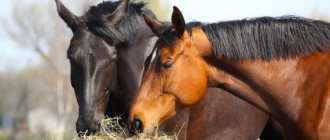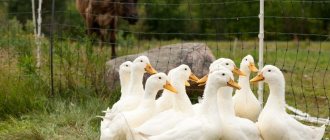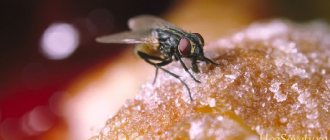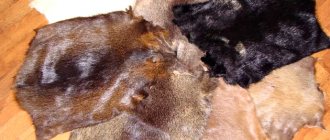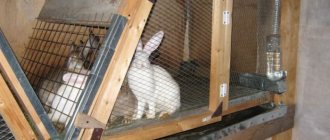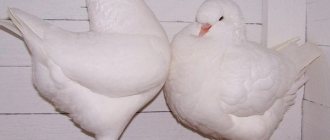Anyone who has a place in their garden at home can keep rabbits to subsequently use the meat for food. These animals are not too demanding to care for and take root easily. It is not difficult to get food for them. It will be enough to devote some 1-2 hours a day to rabbits, and as a result you will get the most tender and delicious meat with dietary qualities. The product is easily digestible, is well digested by the human body, and is recommended for use by children and people on a prescribed diet.
You can have just a few females, which will subsequently produce up to 70 rabbits per year. And this is on average up to two kilograms of meat product. If you have space, you can breed rabbits not only for yourself, but also for later sale. Rabbits eat not only plant foods, but also offal, everything that is unsuitable for humans.
Choice of meat breed
Today, many breed groups have been bred that differ from each other in productive qualities (meat, skin, wool, mixed type, pet). The last type includes decorative animals.
If you need to choose an individual for fattening, then you should take a closer look at the following breeds:
- New Zealand;
- Californian;
- the gray giant;
- Soviet chinchilla;
- Belgian giant (Flanders).
The most popular representatives are Californians and New Zealanders, characterized by rapid weight gain. Fattening of such rabbits lasts 90 days; it is due to their high profitability that these breeds are the most beloved by farmers.
New Zealand rabbits can boast a high percentage of meat yield compared to the weight of the animal itself, and in terms of taste they occupy a leading position. The breed was bred in the United States, and the process of improving the necessary qualities lasted several years. By the 90th day of life, the rabbit gains a weight of 5 kg, the share of pure meat products accounts for about 55%.
New Zealand rabbit
The young animals are distinguished by their early maturity and by the 60th day weigh 2 kg. It is worth noting that their meat is very tender, but the slaughter of rabbits is considered irrational. Animals' paws are covered with thick fur, which allows rodents to be placed in cages with mesh floors without any health problems.
Californians are a younger breed, also related to the meat category. Adult animals are smaller in size than New Zealanders, weighing on average 3-4 kg. Young animals gain weight of about 2 kg in 60 days. The physique of rabbits is strong and dense, due to which the slaughter yield is 60%.
In the post-Soviet space, the greatest popularity is among gray giants, capable of gaining weight up to 7 kg. In addition, rabbits are distinguished by multiple births: from one female they produce up to a dozen rabbits. Such features make rodents the favorites of many farmers, but if we talk about the taste of meat, then it is significantly inferior in taste to American long-eared ones.
How to fatten a rabbit for meat?
The second important factor that allows you to quickly fatten rabbits for meat is good living conditions. Here it is necessary to follow the growing technology, properly prepare and place the rabbitry, and organize the supply of food and water. It is also necessary to decide on the main method of raising rabbits and develop an optimal diet that will ensure full development of the animals.
Note. To keep rabbits, one- or two-tier wooden cages are prepared. The corners of the structure are reinforced with sheet iron. It is convenient to have a double floor in the cages, with the upper tier being a grate through which manure is poured into a tray. This greatly simplifies care and increases the hygiene of cultivation.
Diet for fattening for meat
Nutrition for rabbits includes foods balanced in protein and carbohydrate content. Also, to accelerate weight gain, industrial feed is used, which can be the basis of the diet or added in small proportions.
It is necessary to fatten rabbits at home in accordance with the following recommendations:
- Mandatory use of silage. This is a valuable source of vitamins and minerals, the deficiency of which is especially acute in late winter and spring. To make silage, you can use corn, cabbage leaves, carrot and pea tops. Sunflowers, quinoa, and freshly cut field herbs are also used.
- To quickly gain weight, it is important to provide animals with sources of protein. For this purpose, mixed feed, legumes and cereals are used. Hay is also prepared from legumes and cereal grasses, which is added to food in dried and ground form. It is advisable to combine several types of grains, for example, give the animals wheat, oats and barley alternately.
- Adding branch feed. This is a source of nutrients and vitamins necessary during the period of intensive growth of young animals. For this purpose, branches of willow, linden, acacia, aspen and willow are used.
- Be sure to include root vegetables and melons in your diet. They are an important source of energy and vitamins. Potatoes, pumpkin, and zucchini are suitable food for rabbits. They are pre-boiled and mixed with feed, meal or cake to increase nutritional value.
Vitamin and mineral supplements, which are sold in veterinary pharmacies, contribute to rapid weight gain. Their dosage is indicated in the instructions and must be strictly followed by the breeder. Chalk is added to food for rabbits during periods of intensive growth.
Growing technology
Breeding rabbits for meat at home requires purchasing or constructing cages yourself. The rabbitry should have lighting, a heating system for year-round rearing, and good ventilation. With a small population, adding feed and water and cleaning cages can be done manually, while on large farms these processes are automated using hopper feeders and a nipple drinking system.
The technology for raising rabbits is based on life cycles:
- Mature rabbits aged 4-6 months are allowed to mate;
- The female rabbit comes into heat every 8-9 days and lasts up to 5 days;
- after giving birth, the rabbit’s ability to conceive is restored within 1-2 days;
- an adult female is capable of giving up to 5 litters per year, young female rabbits give 1-2 litters;
- the strongest and healthiest rabbits are selected for fertilization at the rate of 1 male per 8 females;
- the litter per litter for female rabbits of different breeds is 6-18 young rabbits;
- Early maturing breeds are ready for slaughter at the age of 3-4 months.
In order to get a good meat yield and quick payback, it is necessary to maintain optimal housing conditions, promptly vaccinate animals, and organize veterinary examinations.
Growing methods
Raising rabbits for meat involves the use of two different methods: purebred and crossbreeding. In the first case, the strongest and healthiest representatives of the breed are selected for breeding in order to preserve all the best characteristics of the breed. The female and male for mating are selected from different family lines to avoid degeneration. Such mating produces weak, sickly offspring.
Reference. With the purebred rearing method, the optimal mating scheme is the selection of grandchildren and great-grandchildren in the same kin group, as well as nephews and nieces. Closer genes may produce undesirable manifestations in the form of abnormal breed traits and genetic abnormalities.
Interline crossing involves mating the best representatives of different lines or breeds of animals. This method is especially widely used in industrial cultivation.
Broiler feeding
This type of meat production is very common and is often used in large livestock complexes. Broiler fattening involves keeping young animals with their queens until slaughter. Nutritious milk from rabbits promotes rapid weight gain in young animals, while the female can be coated again almost immediately after giving birth.
The main advantage of this technique is cell saving.
It is important to know. With intensive feeding of young animals, the females become severely exhausted, and therefore they need to be given an increased amount of feed so that the milk does not disappear and disturbances in reproductive function do not occur.
California rabbits
Frequent feeding of offspring in violation of sanitation standards (this also happens on some farms) leads to the fact that females begin to suffer from diseases affecting the mammary glands.
It is worth noting that the skin products of broiler rabbits are not of particular value (unlike meat products). The following breeds of rabbits are suitable for this feeding method:
- white giants;
- silver;
- Soviet chinchillas.
All of the above groups are precocious and are able to quickly gain weight while the female feeds them. The average weight of 42-day-old rabbits is about 2-3 kg.
During the lactation period, the female should receive 50% (no less) of concentrated feed in the summer and about 60% in the winter months. Rapid growth of young animals will be achieved if animals can receive 150 grams of protein from one unit of feed. It is recommended to use legume hay for feeding, which contains vitamins and is highly nutritious. As for water, rabbits should have it freely available at all times.
Rabbit breeders' advice
Rabbit breeders on their farm use tricks that help fatten the animal well.
- During fattening, rabbits are divided into groups, which include separate males and females. They also pay attention to the same age and starting weight. Only in this case can you know with confidence that everyone will receive the same amount of food, since in such cases the strong will not take it away from the weak.
- The farm uses small cages in which rabbits are placed for fattening. They are provided with free access to it. The smaller the cage, the less the animal moves, which leads to good weight gain.
- Locomotor activity in rabbits occurs more in the evening; during the day they are calm. Rabbits have their cages darkened during the day to increase their appetite.
Conventional fattening technique
With this method, young animals are separated from their mothers from the second month of life. The basis of nutrition includes concentrated feed. After transplantation, rabbits should receive:
- grain – 45 grams;
- legumes – 450 grams.
Additionally, balanced feed is used in feeding; from the initial norm, the amount of food should be increased by one and a half times for 2 months, and by 3 months, doubled. Young animals can be sent for slaughter at six months of age.
Meat products obtained through the usual fattening method are slightly inferior in taste to broiler products, but here the quality of skins and wool improves, from which they also make a good profit.
White giant
On large rabbit farms with a population of 200 animals or more, both feeding methods are used. Thanks to these methods, females get rest, high-quality meat and suitable skin products are supplied for sale.
In farms with an average number of livestock, up to 200 individuals, fattening methods alternate, as a result of which the breeding stock has time to recuperate the spent strength. If there are less than a hundred birds on the farm, then it is most rational to use conventional fattening, and use broiler feeding once every six months.
At what age are rabbits slaughtered for meat?
When choosing rabbits for slaughter, they are guided only by the age of the animal, but also by a combination of other characteristics: achieving optimal weight, obtaining the necessary fur characteristics. Premature or late slaughter leads to a deterioration in the characteristics of the meat, damage to the fur and its unsuitability for sewing products.
Rules for selecting rabbits for meat:
- Live weight. The most tender and tasty meat of hybrid breeds is obtained when they reach a weight of 1.5-2 kg.
- Regular breeds of rabbits are suitable for slaughter when they reach the age of 4-6 months. Early ripening ones go to meat already at the age of 3 months.
- No shedding. Slaughtering shedding animals does not produce high-quality fur. If the household does not produce skins, then this factor is not taken into account.
- Timing of vaccination. At least 30 days must pass after the last vaccination. Only after this the animal is slaughtered to obtain a meat product.
Feeding rabbits at home is quite simple. In the summer, the rabbitry can be organized outdoors by placing the cages in a place protected from drafts. In winter, the rabbitry is moved to a heated room with a temperature of about 18°C. It is important to regularly clean the cages and ensure that the drinking bowls and feeders are full. Good nutrition, vaccination and quality care are the key to obtaining high-quality meat products and healthy offspring.
Rabbit weight and feeding method: dependence
| Breed group | Fattening from 30 days (grams) | Fattening from 60 days (grams) | Fattening from 90 days (grams) |
| Vienna Blues | 500 | 1400 | 2100 |
| Silver | 500 | 1500 | 2200 |
| Gray giants | 600 | 1500 | 2200 |
| White giants | 600 | 1600 | 2600 |
| Californian | 600 | 1500 | 2300 |
| New Zealand (white) | 600 | 1600 | 2500 |
| Black-brown | 700 | 1600 | 2500 |
Feed stocks
The basis of the rabbit diet is 4 products:
- Hay.
- Fodder beet.
- Barley.
- Green mass.
Greens are available for consumption only in the spring and summer; in cold times, hay and vitamin food supplements will make up for their absence. The grain component is necessary all year round, since raising rabbits at home is only possible if high-calorie food is available.
It is possible to raise livestock on compound feed, but such feeding of rabbits at home is practiced by novice breeders, while experienced farmers use compound feed only when they have a very large number of animals.
When raising rabbits in the village, most of their food is obtained naturally: hay is mowed, beets are grown on the plot, and greens are picked in the surrounding areas. For a herd with 5 breeding females, it is enough to purchase 2 tons of oats per year, most of it is consumed by fattening animals and the breeding male. Mother rabbits are also given oats, but in smaller quantities, since it is not possible to raise rabbits at home with the help of well-fed females; they may have problems with reproduction.
Table 2. Feeding table adopted in the project
| Rabbit diet, g | summer (June-September) | winter (January-May, Oct., Nov., Dec.) | |||||
| grass | concentrate | sol/mel | hay | juicy feed | concert | sol/mel | |
| Fattening rabbits | 700 | 70 | 1 | 150 | 500 | 100 | 1 |
| Male and female rest | 650 | 30 | 1 | 150 | 150 | 40 | 1 |
| Male during mating period | 800 | 40 | 1 | 150 | 200 | 55 | 1 |
| The female is pregnant | 800 | 45 | 1 | 175 | 200 | 60 | 1 |
| Young female brood | |||||||
| age 4-7 months | 900 | 55 | 1 | 250 | 300 | 70 | 1 |
| Sucker females | |||||||
| First half of suction | 1200 | 65 | 1,5 | 200 | 350 | 87,5 | 1,5 |
| Second half of the suction | |||||||
| add. for each little rabbit | 80 | 6 | 12 | 30 | 7 | ||
| Young animals | |||||||
| 1-2 months | 300 | 40 | 0,5 | 70 | 150 | 50 | 0,5 |
| 2-3 months | 400 | 50 | 0,5 | 70 | 200 | 60 | 0,5 |
| 3-4 months | 600 | 80 | 0,5 | 120 | 250 | 90 | 0,6 |
| 4-5 months | 700 | 90 | 0,5 | 135 | 300 | 100 | 0,6 |
What you need to know about nutritional supplements
Growth stimulants are understood as drugs that ensure accelerated development of animals, increase their immunity and enhance immunity to certain diseases. Additives are administered in the quantities required by the animals, taking into account the age characteristics and diet of the rabbits.
Free-range housing requires an increased amount of stimulants, while the caged version, in which the animal’s diet includes large quantities of mixed feed, requires less supplementation.
Silver rabbits
You can get acquainted with the most well-known stimulants and their brief descriptions in the following table.
| Additive name | Description |
| Phos-Bevit | The composition includes B vitamins and butaphosphan. The product has a complex effect, increases the tone of animals, improves metabolic processes, and increases weight. Able to remove toxins from the body |
| Microvitan | Consists of a number of amino acids (alanine, valine, leucine, methionine). Speeds up metabolic processes. When the drug was administered to rabbits, an increase in the functioning of the immune system and an improvement in exterior performance were observed. |
| Nucleopeptide | Contains a number of substances that activate the functioning of the glands. Stimulates the activity of the pancreas, which allows rabbits to grow faster. Additionally, it helps to recover from diseases that have a chronic course. |
| Calphostonic | The composition includes amino acids and mineral complexes that ensure rapid growth and development of animals |
| Flavomycin | Refers to feed antibiotics that increase the digestibility of feed by the body. |
| Greencab 70 | Similar to the previous remedy in terms of the method of action, it further enhances reproductive function |
To choose the most optimal product, it is recommended to consult a veterinarian.
Additionally, you can use various premixes containing vitamin, mineral and protein supplements. Such supplements contain useful substances that strengthen the animal’s body.
Mini home farm format
To build your own small farm, first of all you need to find out from the local administration how far the farm should be from residential buildings. This knowledge will help you avoid getting fined in the future.
Small hillocks are considered the best place for construction. During rainy summer-autumn periods, and when the snow melts in spring, water will not accumulate. As we wrote earlier, rabbits do not like high humidity. The best option would be to concrete the area.
The area of the site must be at least 700 m2 and have an uninterrupted power supply.
Three necessary structures need to be built on the site:
- Shed system (cages for rabbits)
- Refrigeration and slaughterhouse space
- Utility room
- Well for water supply
In mini-farms, caring for and maintaining rabbits takes a small amount of time and does not require much effort.
Winter feeding ration
The basis for feeding rodents in the cold season is hay, but a number of other foods of animal origin will also be needed. These include:
- milk;
- fish fat;
- bone meal.
In addition to this, they provide succulent food, from which vegetables with a laxative effect are excluded. Rabbits gain weight best and grow quickly if they have potatoes and Jerusalem artichoke in their diet. Both crops have high energy value and contain useful components.
Black and brown rabbit
You can see the approximate diet for winter feeding in the following table.
| Name of feed | Percentage |
| Hay | 30-40 |
| Compound feed | 20-40 |
| Juicy food | 20-30 |
| Concentrates | 10 |
Compound feed is considered the best additive, because it contains all the necessary components that ensure high-quality growth of animals. You can buy this food ready-made or make it yourself, which will significantly reduce cash costs.
As for concentrates, they should be included in moderate quantities in the diet of rabbits, despite the fact that such food has a positive effect on weight gain in rodents. Most often, 30 grams of concentrates are given per head in winter. During the warm season, they are removed, because rabbits are able to obtain the necessary vitamins from other foods.
What to feed rabbits for intensive growth at home
Fattening rabbits for meat at home consists of the right combination of natural plant feed, ready-made feed, minerals and vitamin supplements. Food should be high-calorie and varied. Let's take a closer look at the main components of the diet.
- Hay. Meadow grasses are mowed in clear sunny weather and dried for a short time, preferably in direct sunlight to form vitamin D. Feeding animals with rotten and rotten hay is not allowed.
- Grass. Fresh grass should be slightly dried. Rabbits readily eat clover, dandelion leaf, plantain, wheatgrass, and young shoots of nettle. You should not give tops of potatoes, tomatoes, eggplants and other plants of the nightshade family: henbane, nightshade. Poisonous plants such as celandine, sleep grass, buttercup, spurge, and cockle are contraindicated for pets.
- Vegetables. Experienced farmers advise feeding boiled potatoes to quickly gain weight for rabbits. The remaining vegetables are given raw, thoroughly washed and wiped with a napkin. Carrots, beets, corn, zucchini, Jerusalem artichoke, cucumbers, tomatoes. Legumes are fed in limited quantities, as they cause bloating. Cabbage should not be given to fluffies; their weak stomachs are unable to digest it. All root vegetables begin to be fed no earlier than 4 months of age.
- Cereals. For rapid growth, it is better to feed your pets wheat, oats, barley, and corn. These and other grains contain all the necessary components for nutrition, especially in winter. They contain proteins, fats, carbohydrates, and vitamins. Grains are necessary for grinding down the incisors, which are constantly growing in rabbits.
- Compound feed. A balanced concentrated feed consists of crushed cereals and other roughage with added vitamins and minerals. Available in the form of granules, briquettes or in bulk. Complete feeds, food concentrates that are added to succulent and green feeds, and protein and vitamin supplements have been developed. Concentrated supplements are given at a rate of 30g per adult per day. Usually in the summer there is enough seasonal food; compound feed is used mainly in the winter.
- Branches. The annual growth of fruit trees is suitable: apple trees, pears. And also branches of willow, acacia, maple. The use of apricot, elderberry, and bird cherry shoots is not recommended. For a short time, you can give branches of coniferous plants: spruce, juniper.
- Food waste. Fattening rabbits for meat allows the use of food waste: potato peelings, carrots, other vegetables, crackers, cereals, bran, cake. The main thing is that the food does not become moldy or begin to rot. Feeding spoiled food waste leads to poisoning and even death.
Important! If you decide to raise rabbits for meat, make sure that the animals always have clean drinking water. You need to change the water at least once a day, preferably more often. Water containers must be periodically disinfected to avoid the growth of bacteria. It is especially necessary to monitor the purity of water in the summer, when animals drink more and microorganisms multiply especially actively.
When to slaughter
To get high-quality dietary products, you should listen to the following recommendations:
- The meat of animals that have reached the age of 7 months is most valued; this period allows farmers to significantly save on the amount of space on the farm and the feed supply;
- to get better quality meat, it is recommended to castrate males 14 days in advance (before starting to fatten rabbits before slaughter);
- in the fattening shop it is necessary to establish a limited light regime;
- feed containers must be filled at all times, and clean and fresh water must be present in drinking bowls.
Vienna Blue breed
Rabbit meat contains vitamins and minerals, it is recommended for baby food, women during breastfeeding and people engaged in extreme professions. Rabbit meat is well absorbed by the human body, regulates fat metabolism and balances nutrients.
We invite you to join our Zen channel and group on VKontakte or Odnoklassniki, where new articles are published, as well as news for gardeners and livestock breeders.
Similar articles:
- Breed overview: Russian ermine rabbit
- Coniferous branches in the winter diet of rabbits
- Should you give zucchini to rabbits?
How to fatten a rabbit for meat at home
Anyone who has a place in their garden at home can keep rabbits to subsequently use the meat for food. These animals are not too demanding to care for and take root easily. It is not difficult to get food for them. It will be enough to devote some 1-2 hours a day to rabbits, and as a result you will get the most tender and delicious meat with dietary qualities. The product is easily digestible, is well digested by the human body, and is recommended for use by children and people on a prescribed diet.
You can have just a few females, which will subsequently produce up to 70 rabbits per year. And this is on average up to two kilograms of meat product. If you have space, you can breed rabbits not only for yourself, but also for later sale. Rabbits eat not only plant foods, but also offal, everything that is unsuitable for humans.
Initial data for a business plan
The project initiator owns a land plot with an area of 14 acres. It is planned to allocate 4 acres for growing food for rabbits. On the same site there is a barn-type structure in which cages with rabbits will be located. The cost of building a shed is not included in the project. Electricity and water are supplied to the barn. Water comes from our own well.
To implement the project, it is planned to purchase:
– rabbits – 5 pieces,
– rabbits – 50 pieces,
– cells with queen cell – 50 pieces
In total, it is planned to spend 320,200 rubles from our own funds on the purchase of rabbits and equipment for the rabbitry. Also, funds in the amount of 150,674 rubles are required for the purchase of feed and for the initial conduct of activities. Thus, the starting costs are 470,874 rubles.
The initiator of the project decided to purchase baby rabbits of the “California” breed. This breed of rabbits has a litter of 8 to 10 rabbits
Taking into account that some rabbits may die at birth, we assume that each female rabbit gives birth to 7 rabbits. The calculation will be based on the three-bread method of rabbit breeding
Thus, if we purchase 50 rabbits for the project, we can get 1050 rabbits from them in a year.
To calculate feed for rabbits, we use table No. 2.
The costs of registering an enterprise are not included in the calculations.
Features of large species
It may seem that the best breeds for breeding are large breeds, from which you can get a lot of rabbit meat. Giants amaze with their impressive size, but such giants have many disadvantages. When keeping long-eared animals, increased volumes of feed will be required according to the needs of the animals, large spacious cages, and a lot of bedding. In addition, large rabbits are susceptible to obesity and limb deformities.
Although large-bred eared animals have many negative aspects, their cultivation is common among farmers. They are popular for their peaceful disposition, resistance to viral diseases that are found among rabbits, as well as tasty meat and luxurious large skins.
Diseases
How to breed rabbits so they don't get sick? The only sure way is vaccination, maintaining cleanliness and a well-formulated diet.
Young animals are vaccinated against myxomatosis at 28 days. The vaccination is repeated at 120 days.
Vaccination against VGBV is given at 45 days. The procedure is repeated every six months.
The associated vaccine acts immediately against myxomatosis and VGBV. It is done at 45 days. Prevention of pasurellosis is done at 2.5 months. Piperazine is administered to each animal through the mouth (0.5 g per kg of rabbit weight).
At 3 months of age, Baycox or Amprolium is given once for coccidiosis.
Weakened individuals are treated before vaccination.
Preparation of necessary documents
In the rabbit farming industry, it is mandatory to register your business. You can register your business in three ways: Peasant farm (peasant farm), and individual entrepreneur (IP) and personal subsidiary plot.
- Peasant farm. The advantage of this form of ownership is state support in the form of subsidies and preferential conditions. With this registration, you will act as an individual entrepreneur, but with a limited list of rights. It includes only that category of people who have the right to any economic activity. If you run a medium-sized business focused on domestic rabbit breeding, then this form will suit you perfectly.
- Individual entrepreneurship. This is a simple and convenient form of doing business with a large list of possibilities. You can easily move from a small farm to a large livestock complex. In taxation, you can use the unified agricultural tax or a simplified system.
- Personal subsidiary farming. This is the most economical design option in this business. It has the advantage of no taxation on the sale of meat. To obtain this status, you only need to provide a certificate of ownership of a summer cottage. You can get it from compulsory medical insurance. However, if you are planning rabbit breeding on a large scale, then this type of design will not suit you. You will not be able to sell your product in hypermarkets and restaurants, and there will also be a limit on the quantity of products sold.
To obtain a sales permit, you need to prepare the following package of documents:
- Sanitary book
- Certificates from a veterinarian confirming the absence of diseases in rabbits
- Certificates from laboratories where the tests were carried out
- Sanitary certificate of a vehicle for transporting rabbit meat.
The rabbit breeding business involves the purchase of equipment for keeping rabbits. There are three main ways of keeping them: semi-free, aviary and the most common - the cage system. The cellular system is the most convenient for maintaining veterinary requirements and sanitary standards.
Diseases
The body of rabbits is quite delicate and does not have a strong immune system. For this reason, they often pick up various infections. Transmitted from rabbit to rabbit, diseases very quickly affect the entire flock. Typical symptoms of an infectious disease in a pet include:
- lack of appetite;
- body temperature is more than 39 °C;
- discharge from their eyes and nose;
- stomach upset;
- patchy dull fur.
Infectious infections in rabbits cannot be treated. When the first symptoms are detected, the sick animal must be removed from everyone. But this measure does not always protect the flock from death. The best way to prevent infection is timely vaccination.
Reviews
When I started raising rabbits, I wanted to increase the number of heads, I wanted to cut costs, I didn’t buy new cages, I put more rabbits in cages. It turned out that some animals grew small, others grew too fat. The difference in weight reached 1.5 kg. So I decided to reduce the number of heads to 2-3 per cage. My profit increased by 15%. All steps taken must be carefully thought out; it is better to consult a specialist.
Igor
Drinking fountain
Such a device can serve not only to quench the thirst of animals, but also become an original accent in the home interior. The design consists of a water bowl, a filter, a diffuser and a drinking bowl located at the top. Additionally, it is equipped with a decorative sprinkler, especially popular with native breeds (Maine Coons, Kuril Bobtails, Siberian cats).
Continuous circulation of liquid is ensured by a mini-pump powered by a USB cable. More advanced models may contain backlighting and an indication of the level of remaining water in the tank.
Cost – 2400 rub.
Reproduction
Puberty begins at different times in different breeds. The earliest maturity is 4 months. But, on average, rabbits become ready to breed by 6-8 months. It is not worth breeding rabbits earlier, as a female that is too young may have problems producing milk or may have a miscarriage. Rabbits can be raised for meat all year round, but the strongest offspring are born in the cold months.
You should not choose individuals for mating:
- from the same litter;
- obese patients;
- those who were vaccinated less than 20 days ago;
- females prone to devour newborn cubs;
- females with undeveloped or defective nipples.
